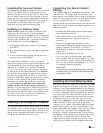
6
YY
YY
Y
English
L-2448B Installation
Installing the Ice Level Sensor
Use Figure 5 to determine placement for the Ice Level
Sensor. The sensor must be located below the ice
delivery hole and to the side, per Figure 5. Drill 23/32"
hole for sensor. Use two lock nuts provided to secure
sensor into hole. Use marine grade sealant around the
hole if desired. Remember that the unit may have to
be removed at some time. Route the cable to the
auger unit, and plug into the matching plug.
Installing Ice Delivery Hose
Figure 5 and 6 shows the proper ice delivery hose
connection. The first step is to install the proper
through-hull in the ice box (Figure 5). This through-hull
must be large enough for the 1¼" ice hose to fit inside
the fitting (use supplied part). It should be installed in
such a manner as to provide (Figure 6):
1) A continuous uphill route of travel from the auger
unit (BEST)
2) A continuous route of travel, with only one high spot
(GOOD)
3) A route of travel which includes one low spot and
two high spots (ACCEPTABLE)
The best routing provides for a level, but slightly
upward rising hose from the auger toward the box, with
very few bends. No bend should be tighter than a
radius of 12". Insulate the full length of hose with
1
5
/
8
" ID, ¾" thick wall insul-tube, minimum. Provide a
¼" hole for an air vent where instructed as in Figure 6.
Do not block with insulation. If there are any dips in
the hose, we suggest that you drill a ¼" hole in the
hose for a water relief. While the water will not prevent
ice flow, it could freeze in low ambient conditions,
preventing ice delivery. Do not block the hole with
insulation. Secure at each end with double hose
clamps, so that the line will not get pulled out. In
addition, PVC glue may also be used at the thru-hull
end. Strap hose to bulkhead securely, keeping in mind
that the hose will be much heavier once filled with ice.
Be careful not to kink or crush hose, because any
obstructions will prevent free flow of ice.
Installing the Refrigerant Linesets
The refrigerant lines may run uphill, downhill, or sloping
as necessary. They can have bends as necessary, but
avoid sharp bends which could result in kinking of the
tubing. Once connections are made, the suction line
should be fully insulated from unit to unit.
Connecting the Quick Connect
Fittings
The linesets, auger and condensing unit all have quick
connects (QC). QC fittings allow for connection and
disconnection of the system with no loss of refrigerant.
Route the lines directly to each unit, and approach the
QC in a straight line. Do not try to screw fittings
together which are not mated correctly, as doing so will
destroy the fittings. Connect the fittings together in the
following method:
• Lubricate the male fitting face and thread lightly
with refrigeration grade oil.
• Hand thread the nut of the female QC onto the
male threaded QC by rotating the union nut
clockwise.
• Tighten the female thread connection with a
wrench while holding the opposite coupling with a
wrench. Exception: The male QC is held by a
metal bracket at each unit, and does not need a
wrench on it.
• Tighten each assembly to 35 ft. lbs.
• If you don’t have a torque wrench, then tighten
each assembly until the fittings “bottom out.” Then
use a marker to make a line on each coupling half
hex. Turn with wrenches an additional
1
/
6
to ¼ turn
to completely seal the assembly.
IMPORTANT
If fittings are cross-threaded together by not using
the steps above, the fittings will be destroyed and
the warranty voided.
Installing the Feed Water System
The feed water for the auger unit should be fresh water
supplied by potable water system of the boat. Use of
saltwater is not recommended because of the damage
it causes to the components of the auger and evapora-
tor barrel. Feed water should be supplied with pressure
of at least 15psi. The water system must be able to
supply at least 4 gallons per hour when the ice maker
is operating. Use of an in-line filter just prior to the
auger unit is required to remove sediment which may
cause occlusion of the needle valve in the water
reservoir, and to reduce scale buildup which will inhibit
system performance, and may cause damage to the
auger components. We suggest a filter that will remove
dirt, rust, odor, and scale, such as Dometic Part
#3150707. Dometic recommends that a shut-off valve
be installed in the feedwater line, between the source
and the filter, to help facilitate filter removal. Run
copper tubing or equal from the water source to the
auger unit, and connect with the supplied connection


















